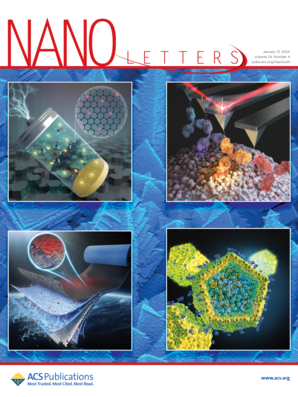纳米结构GaN超材料热释电性能的拓扑依赖性增强
IF 9.6
1区 材料科学
Q1 CHEMISTRY, MULTIDISCIPLINARY
引用次数: 0
摘要
热释电材料在响应温度波动时表现出自发极化,这种现象被称为热释电效应。本研究利用分子动力学模拟研究了具有不同拓扑结构的纳米氮化镓(GaN)超材料的热释电特性,即体心立方体、八柱桁架、陀螺和棘状体。我们的研究结果揭示了热释电系数的拓扑依赖性增强,主要受压电应力常数和热膨胀系数的影响。我们证明了相对密度的降低进一步提高了热释电系数,因为增加了表面体积比,增强了表面效应。最后,我们计算了热能量收集应用的热释电数值,突出了纳米结构GaN超材料与本体GaN和GaN纳米线相比的优越热释电性能。这些结果强调了纳米尺度拓扑工程在热释电领域的潜力,可以实现下一代纳米发电机、热成像器件和自供电纳米传感器。本文章由计算机程序翻译,如有差异,请以英文原文为准。

Topology-Dependent Enhancement of Pyroelectric Property in Nanoarchitected GaN Metamaterials
Pyroelectric materials exhibit spontaneous polarization in response to temperature fluctuations, a phenomenon known as the pyroelectric effect. This study investigates the pyroelectric properties of nanoarchitected gallium nitride (GaN) metamaterials with distinctive topologies, i.e., body-centered cube, octet truss, gyroid, and spinodoid, using molecular dynamics simulations. Our findings reveal a topology-dependent enhancement in the pyroelectric coefficient, primarily affected by the piezoelectric stress constant and thermal expansion coefficient. We demonstrate that decreasing the relative density further enhances the pyroelectric coefficient due to an increased surface-to-volume ratio that enhances the surface effects. Finally, we compute the pyroelectric figures of merit for thermal energy harvesting application, highlighting the superior pyroelectric performance of nanoarchitected GaN metamaterials compared to bulk GaN and GaN nanowires. These results underscore the potential of nanoscale topology engineering in the field of pyroelectricity for realizing next-generation nanogenerators, thermal imaging devices, and self-powered nanosensors.
求助全文
通过发布文献求助,成功后即可免费获取论文全文。
去求助
来源期刊

Nano Letters
工程技术-材料科学:综合
CiteScore
16.80
自引率
2.80%
发文量
1182
审稿时长
1.4 months
期刊介绍:
Nano Letters serves as a dynamic platform for promptly disseminating original results in fundamental, applied, and emerging research across all facets of nanoscience and nanotechnology. A pivotal criterion for inclusion within Nano Letters is the convergence of at least two different areas or disciplines, ensuring a rich interdisciplinary scope. The journal is dedicated to fostering exploration in diverse areas, including:
- Experimental and theoretical findings on physical, chemical, and biological phenomena at the nanoscale
- Synthesis, characterization, and processing of organic, inorganic, polymer, and hybrid nanomaterials through physical, chemical, and biological methodologies
- Modeling and simulation of synthetic, assembly, and interaction processes
- Realization of integrated nanostructures and nano-engineered devices exhibiting advanced performance
- Applications of nanoscale materials in living and environmental systems
Nano Letters is committed to advancing and showcasing groundbreaking research that intersects various domains, fostering innovation and collaboration in the ever-evolving field of nanoscience and nanotechnology.
 求助内容:
求助内容: 应助结果提醒方式:
应助结果提醒方式:


